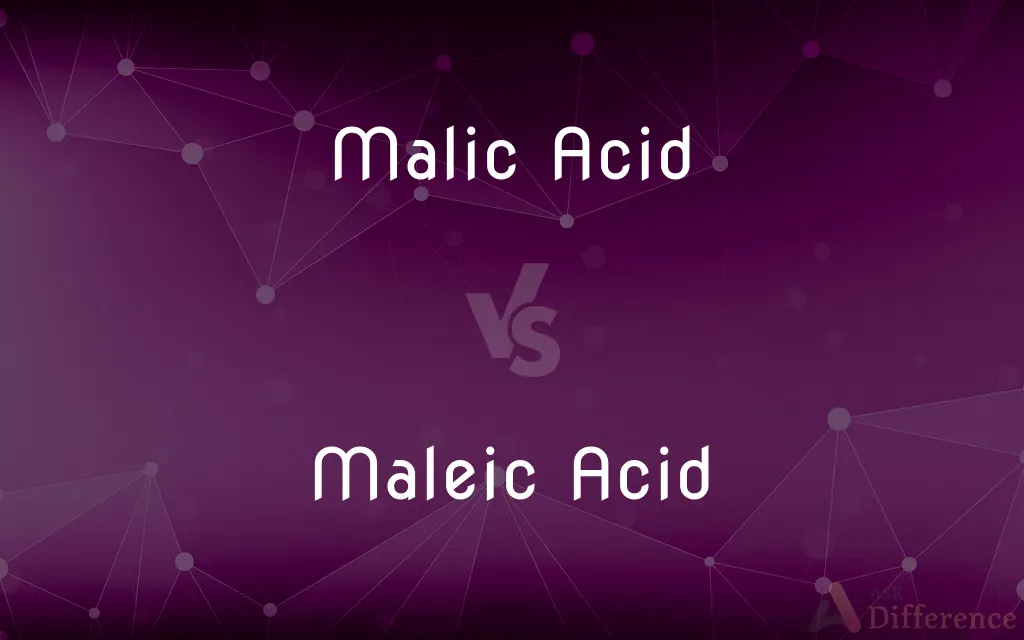Malic Acid vs. Maleic Acid — What's the Difference?
By Tayyaba Rehman — Published on October 23, 2023
Malic acid is a natural acid found in fruits like apples, while maleic acid is a synthetic acid used in industrial processes.

Difference Between Malic Acid and Maleic Acid
Table of Contents
ADVERTISEMENT
Key Differences
Malic acid and maleic acid, despite their phonetic similarities, have distinct characteristics and applications. Malic acid is an organic compound found naturally in many fruits, most notably in apples. It gives these fruits their sour or tart taste. Being an alpha-hydroxy acid, malic acid is also utilized in skincare products to improve skin health and appearance.
Maleic acid, on the other hand, is a dicarboxylic acid that isn't commonly found in nature but is produced industrially. It is an unsaturated organic acid known for its double bond between the two central carbon atoms. Due to its properties, maleic acid is widely used in industrial applications, especially in the production of resins and coatings.
It's essential to be cautious when dealing with these acids, especially in their pure forms. While malic acid is often consumed in the foods we eat, in concentrated forms, it can be corrosive. Similarly, maleic acid, given its industrial applications, can also be corrosive and needs to be handled with care.
A key difference between the two is their molecular structures. Malic acid has hydroxyl groups, making it an alpha-hydroxy acid. In contrast, maleic acid is recognized for its double bond and lacks these hydroxyl groups.
In terms of applications, malic acid's presence in foods and skincare products contrasts sharply with maleic acid's industrial-focused applications. Thus, despite their names sounding similar, malic acid and maleic acid serve very different purposes and should not be confused with each other.
ADVERTISEMENT
Comparison Chart
Origin
Naturally occurring in fruits.
Synthetically produced.
Molecular Structure
Contains hydroxyl groups (alpha-hydroxy acid).
Contains a double bond between central carbons (dicarboxylic acid).
Common Source
Apples and other fruits.
Industrial production.
Applications
Food flavoring, skincare products.
Resin production, industrial coatings.
Nature
Generally safe for consumption in food.
Not commonly consumed, used for industrial applications.
Compare with Definitions
Malic Acid
It is derived from various fruits, especially apples.
Grapes have malic acid, contributing to wine's taste profile.
Maleic Acid
It is not typically found in nature and is produced synthetically.
Maleic acid, unlike malic acid, isn't derived from fruits.
Malic Acid
Malic acid is a naturally occurring organic compound.
Apples contain malic acid, giving them their tart flavor.
Maleic Acid
It can be converted into fumaric acid through isomerization.
The isomerization of maleic acid results in fumaric acid.
Malic Acid
Malic acid is an alpha-hydroxy acid.
Malic acid is used in skincare products to promote smoother skin.
Maleic Acid
Maleic acid is used in the production of resins.
The strength of resins can be attributed to maleic acid components.
Malic Acid
Malic acid plays a role in the Krebs cycle in human metabolism.
Malic acid is vital for energy production within our cells.
Maleic Acid
Maleic acid is valuable for producing coatings and polymers.
Maleic acid's properties make it ideal for certain industrial applications.
Malic Acid
It can improve the taste and preservation of food products.
Malic acid is added to candies to enhance their sour taste.
Maleic Acid
Maleic acid is a dicarboxylic acid with a double bond.
Maleic acid's double bond makes it valuable for industrial processes.
Common Curiosities
Where is maleic acid commonly used?
Maleic acid is used in industrial applications, especially in the production of resins and coatings.
Can we find maleic acid in fruits?
No, maleic acid isn't typically found in fruits; malic acid is the one present in fruits like apples.
What is the main difference between malic acid and maleic acid?
Malic acid is naturally found in fruits like apples, whereas maleic acid is a synthetic dicarboxylic acid used in industries.
Why is malic acid used in skincare products?
As an alpha-hydroxy acid, malic acid can help exfoliate and rejuvenate the skin.
Are malic acid and maleic acid structurally similar?
While they have similar names, their molecular structures are different; malic acid has hydroxyl groups while maleic acid has a central double bond.
Is malic acid safe to consume?
Yes, malic acid is naturally present in many fruits and is safe to consume in typical dietary amounts.
Can maleic acid be used in foods?
Maleic acid isn't typically used as a food additive, while its isomer, fumaric acid, is sometimes used in foods.
What gives apples their tart taste?
The tart taste of apples comes from malic acid.
What role does malic acid play in human metabolism?
Malic acid plays a role in the Krebs cycle, which is vital for energy production in cells.
Is maleic acid safe to eat?
Maleic acid is not commonly consumed and is mainly used for industrial applications.
Can malic acid be synthetically produced?
Yes, while it's naturally found in fruits, malic acid can also be produced synthetically.
Can malic acid be used in industrial applications like maleic acid?
While malic acid's primary uses are in food and skincare, it doesn't have the same industrial applications as maleic acid.
How is maleic acid produced?
Maleic acid is synthetically produced, typically through the oxidation of benzene or butane.
Are there any safety concerns with maleic acid?
Yes, maleic acid can be corrosive and should be handled with care in its concentrated form.
Why are malic acid and maleic acid often confused?
Their names sound similar, but they have different properties, sources, and uses.
Share Your Discovery

Previous Comparison
Machine Learning vs. Artificial Intelligence
Next Comparison
Windows 8 vs. Windows 10Author Spotlight
Written by
Tayyaba RehmanTayyaba Rehman is a distinguished writer, currently serving as a primary contributor to askdifference.com. As a researcher in semantics and etymology, Tayyaba's passion for the complexity of languages and their distinctions has found a perfect home on the platform. Tayyaba delves into the intricacies of language, distinguishing between commonly confused words and phrases, thereby providing clarity for readers worldwide.
















































